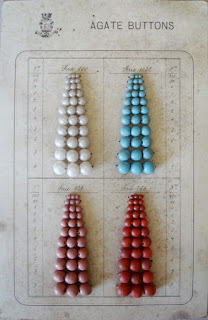In the year of 1840 "Prosser" technique was invented by the Prosser brothers in England for the purpose of making buttons. The technique was molding a cold paste under great pressure and then firing it. It is not clear if the Prossers themselves made any products from their invention. Minton and Chamberlain bought their patent and started producing buttons in 1843 (2, 5).
The same year Jean-Félix Bapterosses left France for a study trip to England and visited the first button-making factories of Minton and Chamberlain. After he returned to France he improved the machines (patented in 1844) to produce 500 buttons at once compared to one like machines seen in England. As a bead collector he realized the potential of the machines and started producing beads in 1860-1864. By improving the machines and paste formula (7, 2, 5) Bapterosses factory produced 400-500 tons of beads per year. One of the ingredients of the formula was milk.
Of-course competitors couldn't keep up with that. Minton stopped making buttons and started to produce high-quality china, Chamberlain made a deal with Bapterosses to use some of his patents (2). Also Czechs (Redlhammer Brothers), Italians ( the Brothers Simonis) and Germans (Risler and Company and Ferd. Schmetz) were very interested and nowadays it is difficult to tell who was making beads and who reselling (read further 2). Because of the use of plastic as a primary source, the competition of less expensive Czech beads, and the independence of the African countries in the 1950s and 60s the demand for Prosser beads declined and ceased by the end of the 20th century (2, 4).
Prosser beads are any beads made by the "Prosser" technique. They look glossy as porcelain, have pronounced equatorial ridges created by mold seams and while one end is typically smooth and somewhat rounded the other end is flat and rougher. This method allows for only opaque colors, not translucent ones.
 |
| Jean Felix Bapterosses (1813-1885). Photo from Hospital Saint Jean site. |
 |
| Milkfarm of the Bapterosses factory in Briare. Photo from beadcollector.net |
 |
| French Prosser beads white opalescent. I got these loose in cotton/linen bag or strung into interesting hanks. |
(see links for more below)
 |
Czech Prosser beads close up - ridges from the mold.
|
 |
| Bapterssoses beads on a sample card. Photo from eBay auction. |
 |
R.B as short for Redlhammer Brother (Czech). They also
had a panther head as logo. After the II WW the panther logo appeared without the RB letters. |
 |
| Beautiful array of bead colors - here are French and Czechoslovakian beads made into bracelets. |
 |
| Black Prosser beads from Bapterosses factory in Briare in original box. |
 |
| Turquoise colored Prosser beads with lustre finish with a paper tag from Briare. |
 |
| Pink Prosser beads made by Redlhammer Brothers. Cardboard box contains loose beads appr. 5000 pieces. Paper wrapping contains beads strung on thread. There is a panther logo on the paper wrapping. |
Aastal 1840 leiutasid Inglismaal Prosseri nimelised vennad portselanist nööpide tegemiseks uudse tehnika. See oli põhimõtteliselt külmalt kokku segatud pasta, mis pressiti tugevalt vormi ning saadud toode kuumutati ahjus. Sellest, kas Prosserid ise midagi oma tehnikas valmistasid, ei ole teada, aga nööbitootjad Minton ja Chamberlain ostsid patendi ning alustasid tootmist 1843 (viide 2, 5).
 |
| Award, Philadelphia, PA - 1876 for Bapterosses & Cie. Photo from Wikipedia. |
Samal aastal külastas Inglismaad Jean-Félix Bapterosses, kes õppimise eesmärgil külastas Minton ja Chamberlaini tehast. Naastes Prantsusmaale suutis ta nähtud tehnikat edasi arendades luua masina (patendeeris 1844), mis ühe nööbi asemel valmistab 500 tükki. Helmeste kollektsioneerijana tabas ta ära võimaluse mugandada masin helmeste valmistamiseks. Aastatel 1860 - 1864 hakkaski tehas helmeid valmistama. Viimistledes masinaid ning külma pasta retsepti paremaks vormimis-omaduste saavutamisel (viide 7, 2, 5) suurenes ta tehase toodang 400-500 tonnini aastas. Üheks koostisosaks oli pastas lehmapiim.
 |
| View of Bapterosses factory with canal where boats delivered feldspar for the paste. Photo from beadcollector.net |
Loomulikult ei suutnud Inglismaa konkurendid sellele vastu, Minton lõpetas nööpide valmistamise ning suundus edasi kõrgkvaliteetse portselani juurde. Chamberlain aga tegi Bapterossesiga kokkuleppe, ostes osaliselt õiguse valmistada uute masinatega helmeid (viide 2). On viiteid, et ka tšehhid (Redlhammer Brothers), itaallased (the Brothers Simonis) ja sakslased (Risler and Company and Ferd. Schmetz) tundsid suurt huvi ning praeguse ajani on keeruline järge ajada, kes tootis prosser-helmeid ise, kes aga müüs edasi (loe rohkem viide 2). Prosser-helmeste valmistamine vähenes1950-60ndatel aastatel ja kadus 20nda sajandi lõpus seoses plastiku kui odavaima materjali kasutusele võtmisega ning suht odavate Tšehhi pressitud klaashelmeste tõttu, samuti Aafrika turu kokkukuivamisega seoses selle riikide iseseisvumistega (viide 2, 4).
Prosser-helmesteks loetakse Prosseri tehnikas valmistatud helmeid. Neile on iseloomulik portselani-moodi läikiv pind, rant pressimisest ning üks pool, mis kuumutamisel vastu ahju põhja oli, on ebaühtlane. Selles tehnikas sai valmistada ainult läbipaistmatuid värve.
More info:
1 Beads from Briare book introduction. by author Floor Kaspers. Available for purchase HERE
2 The French Connection. John and Ruth Picard. 1995
3 Kakamba Prosser Beads. African Beads Wiki.
4 Prosser Beads. Bedazzled.net
5 Emaux de Briare the company. Wikipedia
6 Today Emaux fde Briare site.
8 Bapterosses Bead Sample Card. by Floor Kaspers.
9 PDF: Bapterosses Glass Machine Patent Document for US Patent Office, dated April 20 1880.
10 Bapterosses Machine Patent, dated September 23 1884
More posts on Discovering Glass.














